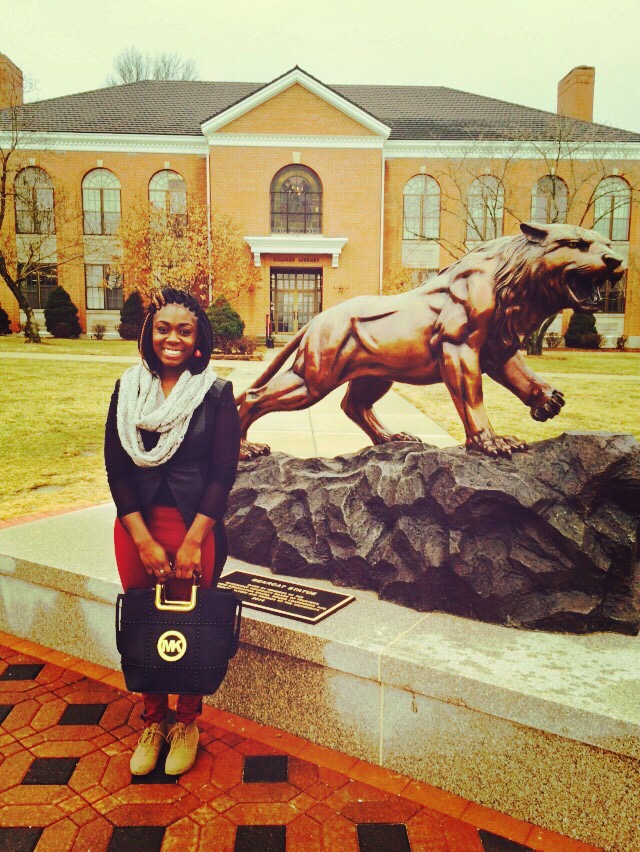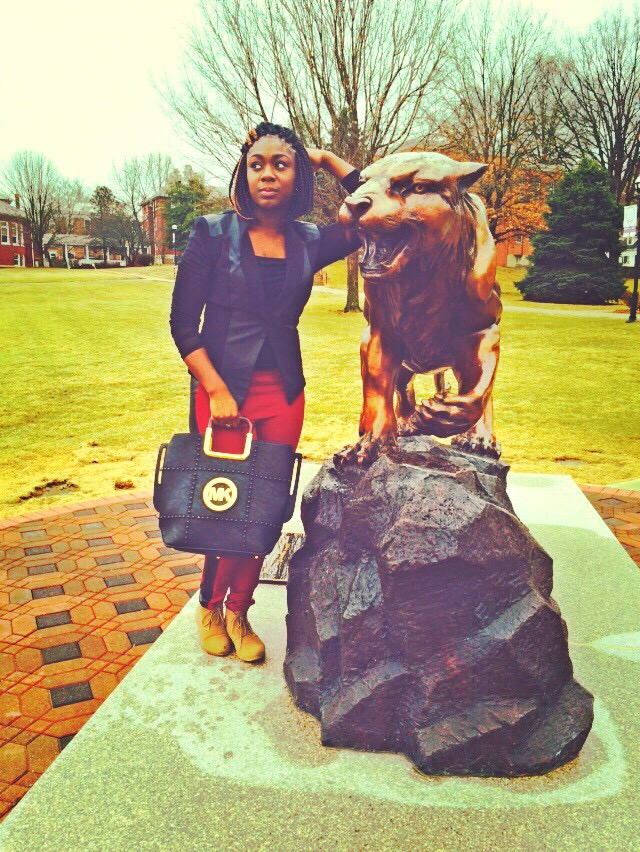By Emily Lucia
Editor in Chief
It all began with the planning of a peace walk, inspired by the events in Ferguson, Mo. The walk was meant to bring the students of all nationalities and ethnicities together. It was to show that McKendree is one, united by learning. On Oct. 29, 2014, what was meant to be something completely harmless, turned into something that would cause a rift among students on campus. Rhoda Warner, a junior at McKendree University, had found her car vandalized.
The walk was originally planned as an interfaith event, but Warner had another idea for this school year’s walk. “Years before we had done the walk on an interfaith level, we just gathered with people of different faiths. And I thought, why don’t we just open it up to the community?” Inspired by the race related events that took place in Ferguson, Mo, Warner wanted to bring the community together, not just on a faith level, but on a level of ethnic diversity. She had spoken with Rev. Tim Harrison and several other faculty members about it, and they were open to this idea.
“We had a meeting with the [Lebanon] Chief of Police and [McKendree] Public Safety to show that unity between officials and students of all cultures, not just African Americans,” Warner explained.

Eventually the Ferguson events were pushed from the plans for the peace walk, and she began to wonder why. “It began to dwell on me, and I kept thinking ‘Why? Why did that have to be excluded?’” After thinking about her questions for a while, Warner soon had an answer. Race. Many will agree that discussing race, as a topic, is difficult. Through the years, race in America has been a topic in which many do not talk about in public because it is such a sensitive subject.
“Talking about race relations, talking about diversity in general, when it boils down to it, is hard,” Warner explained further. “I looked back at the beginning of the semester when all the Mike Brown stuff was happening, they had a forum [on campus]. Not many students showed up, not many faculty showed up; it was more so—the people that take initiative on campus.”
As a college, it is important for these types of events to be held, to better the learning and understanding about what is going on in the world around us. The forums, like the one held concerning the Mike Brown Case, are designed to get the students talking and engaged to find a common ground. Warner, the president of several student organizations as well as a Resident Assistant, felt that the target audience for this forum was not supposed to be the students and faculty who were already engaged in what was unfolding around them, but the students and faculty who dared to shy away from the topic of diversity and race relations. “We are on the campus to do those types of things, to get uncomfortable—to start having those conversations. That’s why we’re here. We’re not here to stay the same as when we came in [as freshmen].”
Warner began to talk to her fellow classmates to see what they thought could be done about this idea of averting conversations about race and diversity. “I am an African-American female, so I obviously identify with my African-American counterparts. But I am also in a lot leadership positions, so I identify a lot with my Caucasian counterparts, my Hispanic counterparts and all of the other ethnic groups on campus because I am involved in so many different things,” she said. “However, I look back at the conversations that my other counterparts would have with me in certain areas and I realized that they don’t mix well with each other.” Warner further explained that no one talks about why there are not more discussions about avoiding the race discussion or what mindset is behind not discussing this controversial topic. The conversation, she believes, should be started in the classrooms and from there, take flight to the dorm rooms, the lounges and then into the real world. After much more thought, she met with Dr. Jonie Bastian and presented her ideas. “There has to be people to start the conversations.” Together, Warner and Dr. Bastian began to work out ideas and form a plan on how this discussion could begin on campus. Eventually they came together with Christine Bahr and several other members of the faculty to discuss a possible game plan to change this problem.
“The students don’t really see what is going on because they’re here for four years and they leave, the faculty are here longer. They see what is going on,” Warner said.
After much discussion, they concluded that the reason behind not having “the conversation” was that McKendree students come from all over the world. Many are from small towns where there is not much diversity and are not quite sure how to react to race, then there are the students from the big cities like Chicago, St. Louis and more, who are completely use to the idea of having a diverse group of students in the same room. They agreed to take this issue to the students. Warner decided that it would be a good idea to speak with the Student Government Association. She attended a meeting and presented her ideas, but the response was not what she expected. “They decided to keep it at a general diversity aspect, which is a good idea, but they were not including race. Not just black and white, but Hispanic as well as the international students,” Warner stated.
It was after that SGA meeting that incidents began to happen. There had been a nasty post on the popular social media app Yik-Yak, but that was only the beginning. A few days after the SGA meeting, Warner was walking to Bothwell Chapel for a meeting. “There were a group of Caucasian men walking, and I walked past them, saying excuse me as I passed. As I walked by them one of them [made a racist comment].” Warner was utterly surprised. “I had never experience something like that. I thought ‘surely they aren’t talking about me?’’’ She was little bit ahead of them when she looked back at them, and the men had been laughing as they entered another building. Warner then went Dr. Bastian, who asked if she knew these students. When she responded no, Warner explained that it was probably because of the issue that she had been speaking about as well as the color of her skin that allowed these men to say such terrible things to her.
The incidents did not stop there. At one point two men followed Warner to her car. For two weeks, these types of incidents happened back to back causing Warner to worry.
“I was suddenly caught in a whirlwind of stuff. It wasn’t even a big deal to me. The more I would think about it, I though sure this was something that I thought other students would think needed to be changed. This is a school that we love and if we are graduating, we need to be citizens of the world, not only citizens of where we came from,” Warner explained.
It was then that incident involving her car occurred. “As soon as I walked outside I saw something bleeding. One my residents came outside, and I fell back. I didn’t know how to feel at this point. I was numb.” Warner then called Public Safety, her R.D. came out to help out as well. Students began to gather to see what had happened to her car. “They didn’t understand how something like this could happen here, even though this kind of thing is happening everywhere. It happened, and it is happening, so how could we not fathom that something like this was happening here?”
When she arrived on campus, everyone was questioning her, asking if she was all right. “It felt like it was happening to someone else,” Warner reflected. “It felt like a defense mechanism, but I felt that I had to move on. I had to continue my routine.”
As if that was not enough, Warner began to receive major backlash from her fellow students. “They would say things like ‘This is what you wanted? You wanted to get people talking so now they’re talking.’” Tensions within the African- American community began to rise as well. “They saw me as the poster child of what was happening.”
What had started out as a simple idea to harmlessly discuss the differences amongst the students and even the human race grew into a conflict that was completely misunderstood. “It wasn’t even an issue of black and white, it was simply to talk about our differences.”
“The whole experience was really hard. But through it all, I was thinking that I feel sorry for the person who did that to me. They say it is a hate crime, but I say that it was a crime of the mind. Because if you don’t have that worldview or an open mind-that compassion, thinking the way someone else would think about something then you are the one who has been done wrong. You didn’t do anything wrong to me.”
Returning to school after winter break, Warner discovered that things had died down as far as the tensions about race were concerned. While she was glad her name was finally out of the spotlight, she was troubled to find that everything was as it had been before the whole debacle. “It was as if the whole idea of inclusion and diversity just sort of died off.” Warner explained. She began to think of what could be done on campus, to keep these conversations alive and of what could be done to open the minds of McKendree students and faculty to the idea of diversity.
When asked why people are so closed minded to the idea of diversity and ethnicity, she said that she could not explain it, just that there are people who do not understand the idea and choose not to understand the idea. “That is where the anger comes from. You have the people who are so passionate about what they stand for, and that group is upset that the non-passionate group does not care or want to care.”
She believes that in order to fix this issue that it should be up to the student leaders and faculty to inspire other students to open their minds to the diversity. She says that it should be a group of people, not an individual, who needs to take the initiative in making this idea of ethnic diversity into a reality.

Warner chose not to dwell on who the vandals might be but instead focused on “the what and the why” and decided to not make it personal. “I felt that if I personalized it, then that anger and rage would come out and I would still have to come to class, I still would have to interact with people, I would become a shell if I thought about who it could have been,” she explained. “I refuse to be a victim, and I refuse to be an angry victim. I love McKendree, and I love the people of McKendree, and I didn’t want that to tarnish the school because of something like that.”
While she views the world in a different way now, she puts her passion first, and it gives her a whole new passion. It is her passion for change that fuels her courage to move forward, and it is something to be admired.
“It’s not done,” Warner enlightened, “This is just the beginning.”